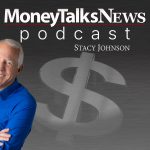Credit Sesame’s personal finance news roundup April 27, 2024. Stories, news, politics, and events impacting personal finance during the past week.
Economic growth slowed in early 2024
The US economy grew at an annual rate of 1.6% in the first quarter of 2024 after adjustment for inflation. This advance estimate of GDP represents a significant slowing of growth after increases of 4.9% in the third quarter of 2023 and 3.4% in the fourth quarter. 1.6% is the slowest growth rate since the second quarter of 2022. The advance estimate is the first of three readings the Bureau of Economic Analysis will make for the first quarter GDP. The second estimate will come on May 30. The one upside of slower growth is that it might help ease inflationary pressure. See GDP release at BEA.gov.
Price increases continued above target in March 2024
The Personal Consumption Expenditures (PCE) price index rose by 0.3% for a second consecutive month in March. The PCE price index is the Federal Reserve’s preferred measure of inflation. Over the past 12 months, the PCE price index has risen by 2.7%. However, the increase in March would put it on pace for a 3.7% annual increase. Both figures are well above the Fed’s target of 2.0% annual inflation. See Personal Income and Outlays release at BEA.gov.
Mounting credit card losses indicates strain on consumers
The latest sign that consumers are struggling with debt came from recent figures on the net loss rate among six major credit card issuers. The net loss rate represents the percentage of credit card debts that credit card companies have decided are uncollectable. Net loss rates increased for four of the six major card issuers in March. The average net loss rate increased from 2.1% in February to 2.3% in March and is up 0.72% year-over-year. Capital One had the highest net loss rate at 3.09%. American Express had the lowest net loss rate, at 1.38%. See details at SPGlobal.com.
Strong dollar is a mixed blessing
The US dollar entered late November on track for its fourth straight months of gains against other major currencies. The rally carried the dollar to its highest level since November. The belief that the US will hold interest rates at current levels for longer than originally expected has helped propel the dollar upward. A strong dollar has both good and bad implications for the economy. On the downside, it makes US-based goods more expensive in other countries. Because of that, the economy could face the headwind of weakening exports. On the other hand, a strong dollar makes foreign imports cheaper. That could ease some of the inflation pressure that has plagued the economy over the past three years. See article at Reuters.com.
Justice Department shuts down online fraud operation
The US Justice Department announced it seized four website domains used in a massive fraud operation. The domains were the source of more than 40,000 spoofed websites. Spoofed sites look like legitimate sites to lure money and information from consumers. In this case, the spoofed sites included ones impersonating retailers and banks such as Amazon, Netflix, Wells Fargo, Bank of America, and Chase. In addition to the spoofed sites, the company at the heart of this operation had stored information on nearly 500,000 credit cards. A Russian internet infrastructure company operating under the name of LabHost was identified as being responsible. See details at SecretService.gov.
Federal Reserve spotlights leading economic risks facing the US
A semi-annual Fed report identified the biggest risks the US faces in today’s economy. The report was based on a survey of financial experts conducted by the Fed. The most frequently cited risk is that the Fed will have to leave interest rates higher for longer than initially anticipated. Already, many economists are conceding that the persistence of inflation seems likely to delay the Fed’s plans to start lowering rates. The report mentioned geopolitical tensions, weaker economic growth, and potential instability in the life insurance industry as other major risks. See article at MSN.com.
Economic indicators turned downward in March
The Conference Board’s Leading Economic Index (LEI) declined by 0.3% in March, more than erasing the 0.2% gain in February. The LEI has decreased by 2.2% over the past six months. The LEI is designed to signal turning points and the near-term direction of the economy. The Conference Board describes conditions for the US economy as fragile but not necessarily recessionary. It expects growth to slow over the next two calendar quarters as consumer spending cools off. See details at Conference-Board.org.
Weekly news headlines from Credit Sesame
Read the full article here

















